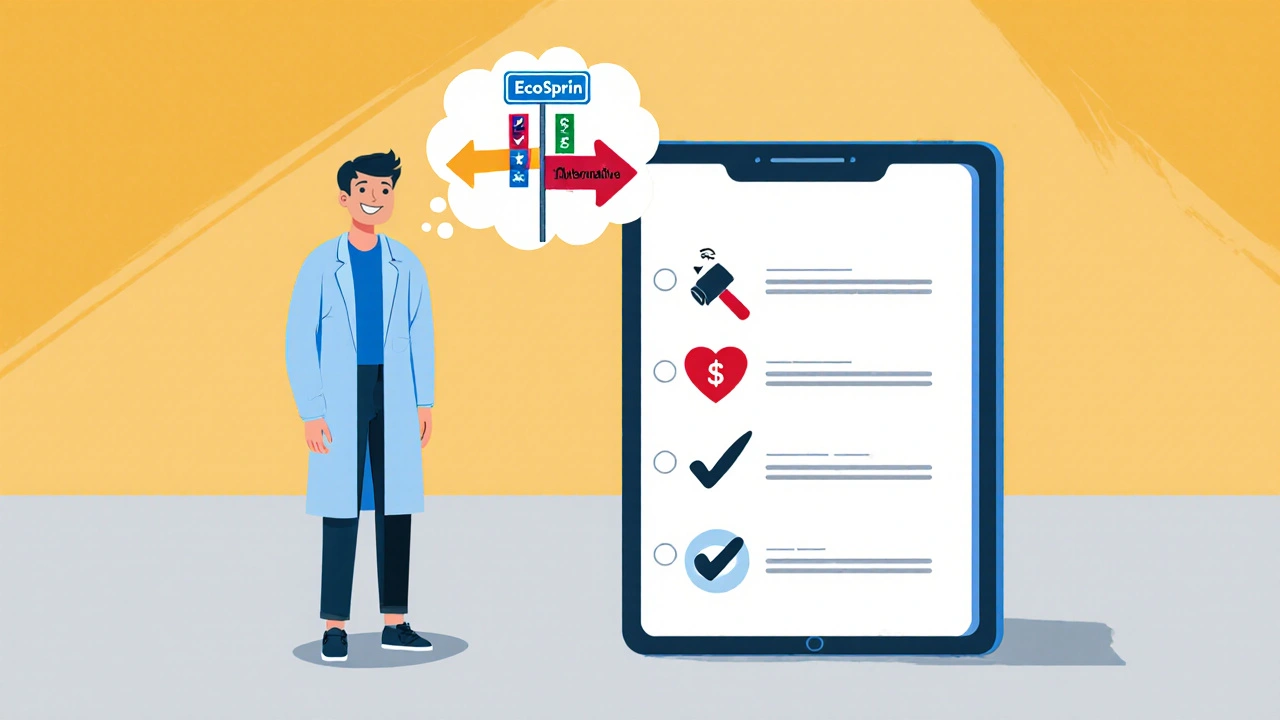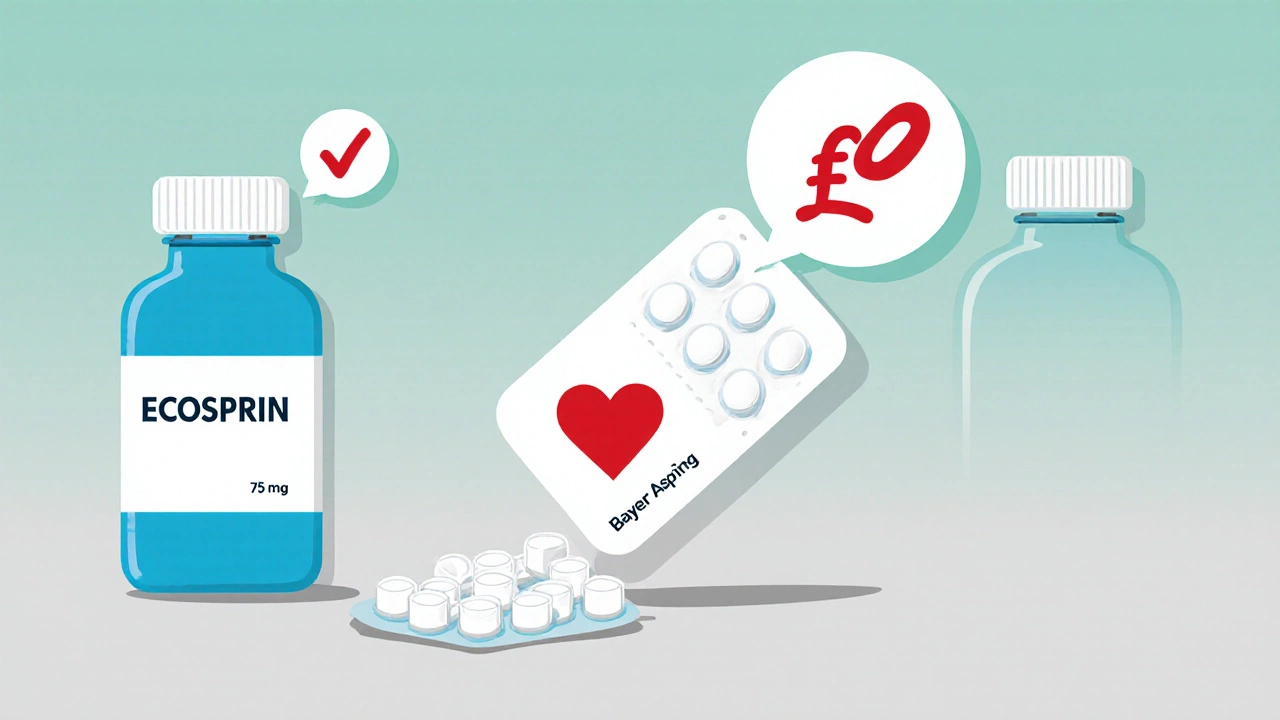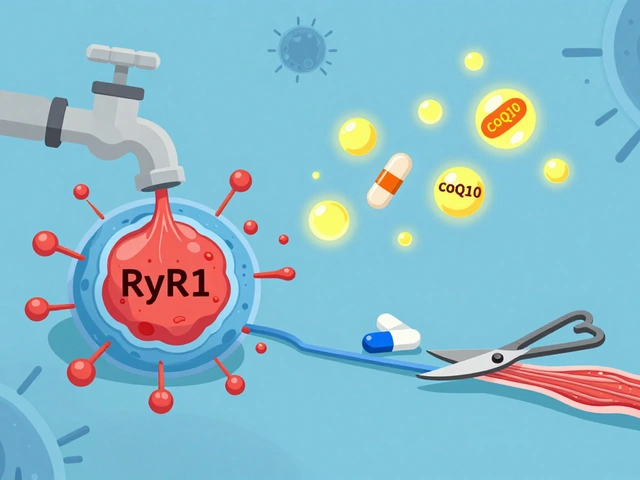Medication Selection Tool
Find Your Best Medication
Answer a few questions to see which medication is most appropriate for your needs.
Key Takeaways
- Ecosprin is a low‑cost, widely studied aspirin brand with strong antiplatelet benefits.
- Non‑aspirin NSAIDs such as ibuprofen and naproxen provide similar pain relief but weaker blood‑clot protection.
- Selective COX‑2 inhibitors (e.g., celecoxib) spare the stomach but may raise cardiovascular risk.
- Antiplatelet drugs like clopidogrel work where aspirin is intolerable, but they are pricier.
- Choosing the right option depends on the primary indication-pain, inflammation, or heart‑attack prevention-and individual risk factors.
What is Ecosprin?
Ecosprin is a branded formulation of acetylsalicylic acid (aspirin) that comes in 75 mg, 150 mg, and 325 mg tablets. It is commonly used for mild‑to‑moderate pain, fever, and as an antiplatelet agent to lower heart‑attack and stroke risk. The drug works by irreversibly inhibiting cyclooxygenase‑1 (COX‑1), which reduces the production of thromboxane A₂, a molecule that makes platelets sticky. This mechanism explains both its pain‑relieving and blood‑thinning effects.
Typical dosing for pain is 325 mg every 4‑6 hours, not exceeding 4 g per day. For cardiovascular protection, a low dose of 75-100 mg once daily is standard. Side effects include gastrointestinal (GI) irritation, bleeding, and, in rare cases, allergic reactions.
Major Alternatives to Ecosprin
When doctors talk about “alternatives,” they usually mean drugs that either share aspirin’s pain‑relief profile or its antiplatelet action. Below are the most common groups.
Other Aspirin Brands
Bayer Aspirin is the original over‑the‑counter aspirin, available in similar dosages to Ecosprin and used for the same indications. Brand differences are mostly pricing and tablet coating; the active ingredient is identical.
Non‑Aspirin NSAIDs
Ibuprofen is an OTC non‑steroidal anti‑inflammatory drug (NSAID) that blocks both COX‑1 and COX‑2, offering pain and fever control. It’s popular for headaches, menstrual cramps, and musculoskeletal pain.
Naproxen is a longer‑acting NSAID that provides 8‑12 hours of relief, useful for arthritis and chronic inflammation.
Diclofenac is a potent NSAID often prescribed for severe joint pain but associated with higher cardiovascular risk.
Selective COX‑2 Inhibitors
Celecoxib is a prescription‑only COX‑2 selective NSAID that minimizes stomach irritation while still reducing inflammation. It is favored for patients with ulcer history, yet long‑term use may increase heart‑attack risk.
Antiplatelet Agents Beyond Aspirin
Clopidogrel is an ADP‑receptor antagonist that prevents platelet aggregation without affecting COX pathways. It’s often combined with aspirin in high‑risk cardiac patients, but alone it is a primary alternative for aspirin‑intolerant individuals.
Ticagrelor is a reversible P2Y12 inhibitor offering faster onset than clopidogrel, used after acute coronary syndromes.
How to Compare: Criteria That Matter
Not all alternatives are created equal. The right choice hinges on a few key factors.
- Primary indication: pain relief vs. antiplatelet protection.
- Gastro‑intestinal safety: risk of ulcers or bleeding.
- Cardiovascular risk profile: whether the drug raises or lowers heart‑attack chances.
- Duration of action: how long relief lasts after a single dose.
- Cost and accessibility: price per tablet and insurance coverage.
- Contra‑indications: asthma, kidney disease, liver disease, or known allergies.
Side‑by‑Side Comparison Table
| Attribute | Ecosprin (Aspirin) | Ibuprofen | Naproxen | Clopidogrel | Celecoxib |
|---|---|---|---|---|---|
| Mechanism | Irreversible COX‑1 inhibition | Reversible COX‑1/COX‑2 inhibition | Reversible COX‑1/COX‑2 inhibition | ADP‑P2Y12 receptor blockade | Selective COX‑2 inhibition |
| Primary use | Pain + antiplatelet | Pain/inflammation | Chronic pain/inflammation | Antiplatelet (aspirin‑intolerant) | Inflammation, arthritis |
| GI bleeding risk | Moderate‑high (dose‑dependent) | Moderate | Low‑moderate | Low | Low |
| Cardiovascular impact | Protective (low‑dose) | Neutral to slight increase | Neutral | Protective | Potential increase at high dose |
| Half‑life | 3‑6 hours (platelet effect lasts 7‑10 days) | 2‑4 hours | 12‑17 hours | 6‑8 hours | 11 hours |
| Typical OTC dose | 325 mg every 4‑6 h (max 4 g/day) | 200‑400 mg every 4‑6 h (max 1.2 g) | 250‑500 mg twice daily | Prescription: 75 mg daily | Prescription: 100‑200 mg daily |
| Cost (USD per tablet) | ~$0.05 | ~$0.08 | ~$0.10 | ~$1.20 | ~$1.50 |
When to Pick Ecosprin Over Others
If your main goal is to prevent a heart attack or stroke, especially after a previous event, low‑dose Ecosprin remains the first‑line choice. Its irreversible platelet inhibition is well documented, cheap, and covered by most insurers.
For short‑term pain (headache, toothache, minor sprain), a single 325 mg tablet works just as well as ibuprofen, but remember the higher GI risk. If a patient has a history of ulcers, switching to ibuprofen, naproxen, or celecoxib may lower stomach trouble, yet the antiplatelet benefit disappears.
Patients who develop aspirin‑induced asthma or severe gastric irritation can be moved to clopidogrel. The trade‑off is cost and the need for a prescription.
When chronic inflammation is the primary complaint-such as osteoarthritis-naproxen’s longer half‑life offers convenience, while celecoxib spares the stomach but demands careful heart monitoring.

Practical Tips for Switching or Adding Therapies
- Check for drug interactions. NSAIDs can blunt the effect of certain antihypertensives (e.g., ACE inhibitors) and increase potassium levels when combined with spironolactone.
- Stagger doses. If moving from aspirin to a non‑aspirin NSAID, wait at least 24 hours to avoid additive GI risk.
- Use gastro‑protective agents. A proton‑pump inhibitor (PPI) like omeprazole reduces ulcer risk when aspirin is unavoidable.
- Monitor labs. Baseline creatinine and liver enzymes help catch NSAID‑induced renal stress early.
- Educate patients. Explain that the antiplatelet effect of aspirin lasts a week, so they should not miss daily doses.
Common Pitfalls & Safety Red Flags
Even a well‑known drug like aspirin can cause trouble if misused.
- Over‑dosing. Taking more than 4 g/day dramatically raises bleeding risk and can cause tinnitus.
- Combining with anticoagulants. Warfarin or DOACs plus aspirin increase major bleed rates by up to 60%.
- Ignoring contraindications. Active peptic ulcer, severe liver disease, or known hypersensitivity are absolute no‑gos.
- R‑eye syndrome in children. Never give aspirin to kids with viral infections; opt for acetaminophen instead.
Quick Checklist Before Choosing
- Is the primary need pain relief, anti‑inflammation, or platelet inhibition?
- Does the patient have a history of GI bleeding or ulcer disease?
- Are there existing cardiovascular conditions that demand antiplatelet therapy?
- What is the patient’s budget and insurance coverage?
- Any known drug allergies or asthma triggered by aspirin?
Answering these questions guides you to the most appropriate option-whether that stays with Ecosprin or shifts to another agent.
Can I take Ecosprin with ibuprofen for extra pain relief?
Generally it’s not recommended to stack two NSAIDs because the combined GI and renal risks rise sharply. If extra pain control is needed, talk to a doctor about a short‑term switch rather than concurrent use.
Is low‑dose Aspirin (Ecosprin) safe for people with high blood pressure?
Low‑dose aspirin is usually safe, but it can blunt the effect of some antihypertensives. Regular monitoring of blood pressure is advised, especially when starting therapy.
Why might a doctor prescribe clopidogrel instead of aspirin?
Clopidogrel is chosen when a patient cannot tolerate aspirin due to ulcer disease, asthma, or an allergic reaction. It provides antiplatelet protection without the COX‑1 related GI irritation.
Does celecoxib increase the chance of heart attacks?
Yes, especially at higher doses or with long‑term use. Patients with known cardiovascular disease should generally avoid celecoxib or use the lowest effective dose.
How long does the antiplatelet effect of a single aspirin tablet last?
Even though the drug’s plasma half‑life is 3‑6 hours, the irreversible platelet inhibition persists for the lifetime of the platelet-about 7‑10 days. That’s why missing a daily dose can reduce protection.



 Medications
Medications





Ben Durham
October 26, 2025 AT 17:50Ecosprin remains a solid choice for low‑dose antiplatelet therapy, especially when cost is a concern. Its irreversible COX‑1 inhibition provides reliable platelet protection that’s hard to match. For patients who can tolerate the modest GI risk, it’s hard to find a cheaper alternative with the same evidence base. Keep an eye on drug interactions, particularly with antihypertensives, to maintain overall safety.
Chris L
November 3, 2025 AT 14:50Totally agree, the price point makes Ecosprin attractive for many health systems. When you match it with a PPI, the GI side‑effects drop noticeably. It’s a straightforward regimen that many clinicians feel comfortable prescribing.
Charlene Gabriel
November 11, 2025 AT 11:50When you look at the landscape of antiplatelet and analgesic options, Ecosprin occupies a unique intersection of affordability, extensive research, and dual functionality.
Its low‑dose formulation (75‑100 mg) is the cornerstone for secondary prevention of myocardial infarction and stroke, and the evidence for this indication stretches back decades.
At the same time, the 325 mg tablets give you a reliable over‑the‑counter analgesic that competes head‑to‑head with ibuprofen for acute pain relief.
One of the biggest advantages is the predictability of its pharmacodynamics; once a platelet is acetylated, the effect lasts for the life of that cell, about 7‑10 days, which simplifies adherence counseling.
However, the same irreversible action is what drives the bleeding risk, especially at higher doses or in patients with a history of gastric ulcers.
For that reason, many physicians co‑prescribe a proton‑pump inhibitor or switch to a COX‑2‑selective agent when ulcer disease is a concern.
Speaking of COX‑2 inhibitors, celecoxib offers a kinder stomach but brings its own cardiovascular cautions, meaning the decision tree often hinges on the individual’s heart health profile.
Non‑aspirin NSAIDs such as ibuprofen and naproxen fill the gap where aspirin’s antiplatelet effect isn’t needed, yet they lack the long‑lasting platelet inhibition that makes low‑dose aspirin indispensable after a heart event.
For patients who cannot tolerate aspirin at all-due to asthma, severe gastritis, or anaphylaxis-clopidogrel and ticagrelor serve as valuable alternatives, albeit at a higher cost and with the need for prescription monitoring.
The cost differential is striking: a bottle of Ecosprin tablets can be purchased for pennies, while clopidogrel often runs over a dollar per tablet, influencing insurance coverage decisions.
From a pharmacokinetic perspective, the half‑life of aspirin is short, but the functional half‑life is essentially tied to platelet turnover, a nuance that sometimes confuses patients who wonder why they must take a daily dose.
Moreover, the simplicity of a once‑daily regimen improves compliance compared to the multiple‑daily dosing required for ibuprofen or naproxen for chronic pain.
On the flip side, for chronic inflammatory conditions like osteoarthritis, the longer duration of naproxen’s action can reduce dosing frequency and improve quality of life.
In practice, I find that a stepwise approach-starting with low‑dose Ecosprin for cardiovascular protection, adding a PPI if needed, and only escalating to alternative NSAIDs or antiplatelets when contraindications arise-covers most clinical scenarios efficiently.
In summary, the choice between Ecosprin and its alternatives should be guided by the primary therapeutic goal, the patient’s gastrointestinal and cardiovascular risk profile, and, of course, the economic considerations that affect adherence.
By weighing these factors thoughtfully, clinicians can tailor therapy that maximizes benefit while minimizing harm, which is the ultimate aim of personalized medicine.
Leah Ackerson
November 19, 2025 AT 08:50Feeling the weight of centuries of aspirin usage makes one wonder if we’re merely pawns in a pharmaceutical chess game 🧩. The irony is that a tiny tablet, priced like candy, can dictate the fate of a heart attack, yet the same industry whispers about hidden profit motives 😏. While the data touts low‑dose Ecosprin as a hero, don’t forget the silent narratives about marketing influence and patent extensions 🕵️♀️. Still, the drug does what it promises-thinning blood and easing a headache-so perhaps we can coexist with this modest miracle, eyes open and emojis ready 🤷♀️.
Gary Campbell
November 27, 2025 AT 05:50Ever notice how the same companies that push cheap aspirin also fund the studies that proclaim its supremacy? There’s a whole ecosystem of “research” that seems designed to keep the public hooked on the low‑margin, high‑volume product while sidelining newer, potentially safer alternatives. It’s not just about profit; it’s about control of the narrative, and the data we see are often filtered through corporate lenses. Keep asking who benefits beyond the patient, because the answer rarely stays simple.
abidemi adekitan
December 5, 2025 AT 02:50Picture the pharmacy aisle as a vibrant canvas, each drug a splash of hue-Ecosprin the steady blue, ibuprofen the bold red, and clopidogrel a daring violet. When a patient’s story calls for a gentle brushstroke on the stomach, we might dip into the soothing greens of a PPI‑co‑prescribed regimen. Yet, when the canvas demands bold strokes for a raging joint pain, the long‑acting orange of naproxen paints a smoother picture. By matching the palette to the patient’s unique masterpiece, we turn medicine into art.
Barbara Ventura
December 12, 2025 AT 23:50Honestly, I just stick with the low‑dose aspirin and call it a day.
laura balfour
December 20, 2025 AT 20:50Oh, but the drama of a single pill hiding in plain sight is like a Shakespearean tragedy-full of unseen wounds, hidden loyalties, and the quiet whisper of a heart that beats a little faster! The tragedy? Ignor‑ing the subtle risk of GI bleeds that lurk, under the surface. Yet the hero-Ecosprin-marches on, cheap and brave, saving lives while we debate its verses. Often we forget the script is written in science, not just in myth.